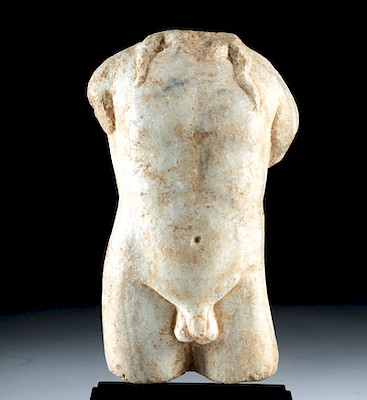Egyptian Bronze Seated God Anubis
Lot 3d
About Seller
Artemis Fine Arts
686 S Taylor Ave, Ste 106
Louisville, CO 80027
United States
Selling antiquities, ancient and ethnographic art online since 1993, Artemis Gallery specializes in Classical Antiquities (Egyptian, Greek, Roman, Near Eastern), Asian, Pre-Columbian, African / Tribal / Oceanographic art. Our extensive inventory includes pottery, stone, metal, wood, glass and textil...Read more
Estimate:
$900 - $1,400
Absentee vs Live bid
Two ways to bid:
- Leave a max absentee bid and the platform will bid on your behalf up to your maximum bid during the live auction.
- Bid live during the auction and your bids will be submitted real-time to the auctioneer.
Bid Increments
| Price | Bid Increment |
|---|---|
| $0 | $25 |
| $300 | $50 |
| $1,000 | $100 |
| $2,000 | $250 |
| $5,000 | $500 |
| $10,000 | $1,000 |
| $20,000 | $2,500 |
| $50,000 | $5,000 |
| $100,000 | $10,000 |
| $200,000 | $20,000 |
About Auction
By Artemis Fine Arts
Dec 5, 2018
Set Reminder
2018-12-05 10:00:00
2018-12-05 10:00:00
America/New_York
Bidsquare
Bidsquare : DAY 1 | Classical Antiquities & Asian Art
https://www.bidsquare.com/auctions/artemis-gallery/day-1-classical-antiquities-asian-art-3698
Day 1 of an important 2-day auction featuring ancient and ethnographic art from around the world. Egyptian, Greek, Roman, Viking, Near Eastern plus Asian Art from China, Japan, Thailand, Vietnam, Burma, India, more. Artemis Fine Arts info@artemisgallery.com
Day 1 of an important 2-day auction featuring ancient and ethnographic art from around the world. Egyptian, Greek, Roman, Viking, Near Eastern plus Asian Art from China, Japan, Thailand, Vietnam, Burma, India, more. Artemis Fine Arts info@artemisgallery.com
- Lot Description
Egypt, Late Dynastic Period, 26th Dynasty, ca. 664 to 525 BCE. A gorgeous cast-bronze seated figurine depicting Anubis, the jackal-headed god of embalming and the dead. He sits with straight legs atop an integral throne with both arms draped gently across the kilt which covers his thighs. His zoomorphic face boasts a conical snout, recessed ovoid eyes, and flowing fur which comprises his mane, and wears the crown of Upper Egypt together with a pair of uraei and feathers resting upon a pair of ram horns. Covered in layers of lustrous espresso-hued patina, this is a wonderful figurative depiction of Anubis! Custom wooden display stand included. Size: 1.125" W x 3.5" H (2.9 cm x 8.9 cm); 4.875" H (12.4 cm) on included custom stand.
Anubis is also associated with Wepwawet (Upuaut), an Egyptian god based on the African golden wolf, with grey or white fur in contrast to that of Anubis. Together, they were worshipped at the city of Asyut which was called "Lycopolis" (city of wolves) by the Greeks. In 1895, American traveler William Vaughn Tupper described Asyut: "In the hills seen on the horizon are the tombs of the priests and numberless holes in the rocks once filled with mummies of the Jackal...the hills are now strewn with skulls and bones of the Jackals" (from the William Vaughn Tupper Scrapbook Collection, Boston Public Library).
Provenance: private New York, New York, USA collection; ex-private lifetime collection of Dr. Saul Tuttman and Dr. Gregory Siskind, New York, New York, USA
All items legal to buy/sell under U.S. Statute covering cultural patrimony Code 2600, CHAPTER 14, and are guaranteed to be as described or your money back.
A Certificate of Authenticity will accompany all winning bids.
We ship worldwide and handle all shipping in-house for your convenience.
#139431One ram horn missing. Minor nicks and losses to one hand, throne, body, head, and crown, with softening to some finer details, and light encrustations. Nice earthen deposits and great brown patina throughout. Old inventory label beneath base.Condition
- Shipping Info
-
All shipping is handled in-house for your convenience. Your invoice from Artemis Gallery will include shipping calculation instructions. If in doubt, please inquire BEFORE bidding for estimated shipping costs for individual items.
-
- Buyer's Premium



 EUR
EUR CAD
CAD AUD
AUD GBP
GBP MXN
MXN HKD
HKD CNY
CNY MYR
MYR SEK
SEK SGD
SGD CHF
CHF THB
THB














